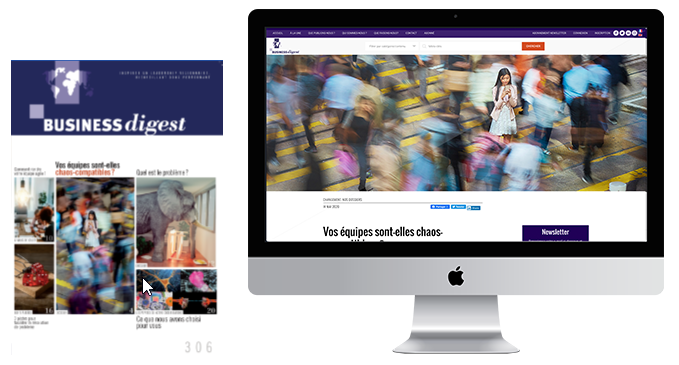L’ensemble des contenus Business Digest est exclusivement réservé à nos abonnés.
Nous vous remercions de ne pas les partager.

Every morning, 41% of smartphone owners connect to the internet as soon as they wake up.
True
False
Right !
79% of smartphone owners check their devices within 15 minutes of waking up every morning. According to a study by Chicago University, it is more difficult to do without social networks than it is to give up smoking. “There’s no escaping reality,” says Eyal, “We’re all hooked! The technologies we use have turned into compulsions or even genuine addictions.” While marketing executives are all engaged in a fierce struggle to capture the attention of customers, many can only look on in envy at the alluring power of some innovations. Eyal believes that success owes nothing to chance. If some companies are outstanding in this field (especially on the web), it is because they have been able to propel their users to adopt new habits.
Based on Hooked: How to Build Habit-Forming Products by Nir Eyal (Portfolio, November 2014).
Based on Hooked: How to Build Habit-Forming Products by Nir Eyal (Portfolio, November 2014).
Wrong !
79% of smartphone owners check their devices within 15 minutes of waking up every morning. According to a study by Chicago University, it is more difficult to do without social networks than it is to give up smoking. “There’s no escaping reality,” says Eyal, “We’re all hooked! The technologies we use have turned into compulsions or even genuine addictions.” While marketing executives are all engaged in a fierce struggle to capture the attention of customers, many can only look on in envy at the alluring power of some innovations. Eyal believes that success owes nothing to chance. If some companies are outstanding in this field (especially on the web), it is because they have been able to propel their users to adopt new habits.
Based on Hooked: How to Build Habit-Forming Products by Nir Eyal (Portfolio, November 2014).
Based on Hooked: How to Build Habit-Forming Products by Nir Eyal (Portfolio, November 2014).
Customer attention is a resource that few know how to capture.
True
False
Right !
In an environment saturated with information and demands, the ability to capture, maintain, and hold attention is key to your effectiveness as a leader. When asked, “Do you feel that you have a “customer orientation?” leaders almost invariably respond affirmatively. Of course, everyone agrees that customer orientation is decisive when it comes to building competitive advantage. And yet, too few actually manage to adapt to an environment that has strengthened the power and influence of customers. So, how can you hook customers into not being able to live without your service or product and who extol its merits? That may be a dream for many firms, but it is already the reality for Apple, Amazon, Ikea and Facebook. According to Nir Eyal, much of the seductive power of these marketing champions rests in their ability to influence the habits of their customers so as to increase their brand loyalty.
Based on Hooked: How to Build Habit-Forming Products by Nir Eyal (Portfolio, November 2014).
Based on Hooked: How to Build Habit-Forming Products by Nir Eyal (Portfolio, November 2014).
Wrong !
In an environment saturated with information and demands, the ability to capture, maintain, and hold attention is key to your effectiveness as a leader. When asked, “Do you feel that you have a “customer orientation?” leaders almost invariably respond affirmatively. Of course, everyone agrees that customer orientation is decisive when it comes to building competitive advantage. And yet, too few actually manage to adapt to an environment that has strengthened the power and influence of customers. So, how can you hook customers into not being able to live without your service or product and who extol its merits? That may be a dream for many firms, but it is already the reality for Apple, Amazon, Ikea and Facebook. According to Nir Eyal, much of the seductive power of these marketing champions rests in their ability to influence the habits of their customers so as to increase their brand loyalty.
Based on Hooked: How to Build Habit-Forming Products by Nir Eyal (Portfolio, November 2014).
Based on Hooked: How to Build Habit-Forming Products by Nir Eyal (Portfolio, November 2014).
45% of our daily actions are governed by habit.
True
False
Right !
A benchmark study by psychologist Wendy Wood1 in 2002 concluded that 45% of the actions we perform on a daily basis are governed by habit. On the other hand, not all of our unconscious actions should be labeled habits. Noting that small “free” activities occupy a significant place in our
schedules, more and more marketing executives are taking a closer interest in the mechanisms that drive our habits. Firstly, anything that becomes a consumption trend has an especially high “customer lifetime value” (the revenue generated per customer between the first contact and the end of the relationship). Secondly, a consumer who is hooked is less sensitive to variations in price.
Based on Hooked: How to Build Habit-Forming Products by Nir Eyal (Portfolio, November 2014).
schedules, more and more marketing executives are taking a closer interest in the mechanisms that drive our habits. Firstly, anything that becomes a consumption trend has an especially high “customer lifetime value” (the revenue generated per customer between the first contact and the end of the relationship). Secondly, a consumer who is hooked is less sensitive to variations in price.
Based on Hooked: How to Build Habit-Forming Products by Nir Eyal (Portfolio, November 2014).
Wrong !
A benchmark study by psychologist Wendy Wood1 in 2002 concluded that 45% of the actions we perform on a daily basis are governed by habit. On the other hand, not all of our unconscious actions should be labeled habits. Noting that small “free” activities occupy a significant place in our
schedules, more and more marketing executives are taking a closer interest in the mechanisms that drive our habits. Firstly, anything that becomes a consumption trend has an especially high “customer lifetime value” (the revenue generated per customer between the first contact and the end of the relationship). Secondly, a consumer who is hooked is less sensitive to variations in price.
Based on Hooked: How to Build Habit-Forming Products by Nir Eyal (Portfolio, November 2014).
schedules, more and more marketing executives are taking a closer interest in the mechanisms that drive our habits. Firstly, anything that becomes a consumption trend has an especially high “customer lifetime value” (the revenue generated per customer between the first contact and the end of the relationship). Secondly, a consumer who is hooked is less sensitive to variations in price.
Based on Hooked: How to Build Habit-Forming Products by Nir Eyal (Portfolio, November 2014).
New technologies have radically changed our attention processes.
True
False
Right !
With an infinite array of distractions just one click away, attention may seem like a scarcer and more fleeting resource than ever before. According to Captivology author Ben Parr, this is both true and not true. Technology has increased the amount of information that is available and made it possible to connect with more people, ideas and resources around the world. Standing out and getting noticed amidst this new wealth of information and connections has thus become a more significant, valuable ability. At the same time, these developments have not really changed the fundamental cognitive processes that drive attention, which have been evolving over the past 200,000 years. Parr’s findings after two years of research reveal that the mechanisms that enable you to capture
and hold attention over the long term are relatively timeless but rarely mastered.
Based on Captivology: The science of capturing people’s attention by Ben Parr (Harper Collins, March 2015).
and hold attention over the long term are relatively timeless but rarely mastered.
Based on Captivology: The science of capturing people’s attention by Ben Parr (Harper Collins, March 2015).
Wrong !
With an infinite array of distractions just one click away, attention may seem like a scarcer and more fleeting resource than ever before. According to Captivology author Ben Parr, this is both true and not true. Technology has increased the amount of information that is available and made it possible to connect with more people, ideas and resources around the world. Standing out and getting noticed amidst this new wealth of information and connections has thus become a more significant, valuable ability. At the same time, these developments have not really changed the fundamental cognitive processes that drive attention, which have been evolving over the past 200,000 years. Parr’s findings after two years of research reveal that the mechanisms that enable you to capture
and hold attention over the long term are relatively timeless but rarely mastered.
Based on Captivology: The science of capturing people’s attention by Ben Parr (Harper Collins, March 2015).
and hold attention over the long term are relatively timeless but rarely mastered.
Based on Captivology: The science of capturing people’s attention by Ben Parr (Harper Collins, March 2015).
Novel stimulus captures immediate attention.
True
False
Right !
And without them, we tend to miss the point. The first stage of attention is the simplest. It lasts only a couple of seconds and is driven by “near-instantaneous mental and emotional impressions and gut reactions,” writes Parr, who explains: “Immediate attention is all about reaction, recognition, and standing out.” If somebody fires a gun in the air, you’re going to turn your head. Sensory cues like these direct our attention automatically. People are hardwired to detect changes in their environments and, particularly, potential threats. This translates into a universal bias for novel stimuli. “We are constantly shifting our attention from object to object, looking for anything that is dangerous, interesting, or novel until we decide to focus our attention on something.”
Based on Captivology: The science of capturing people’s attention by Ben Parr (Harper Collins, March 2015).
Based on Captivology: The science of capturing people’s attention by Ben Parr (Harper Collins, March 2015).
Wrong !
And without them, we tend to miss the point. The first stage of attention is the simplest. It lasts only a couple of seconds and is driven by “near-instantaneous mental and emotional impressions and gut reactions,” writes Parr, who explains: “Immediate attention is all about reaction, recognition, and standing out.” If somebody fires a gun in the air, you’re going to turn your head. Sensory cues like these direct our attention automatically. People are hardwired to detect changes in their environments and, particularly, potential threats. This translates into a universal bias for novel stimuli. “We are constantly shifting our attention from object to object, looking for anything that is dangerous, interesting, or novel until we decide to focus our attention on something.”
Based on Captivology: The science of capturing people’s attention by Ben Parr (Harper Collins, March 2015).
Based on Captivology: The science of capturing people’s attention by Ben Parr (Harper Collins, March 2015).
What attracts attention is almost immediately forgotten.
True
False
Right !
People don’t retain anything in their working memories until the moment when, at least on some level, they consciously choose to focus on it. “(People) don’t have time to evaluate the merits of every person, company, or idea (they) encounter,” notes Parr. As a result, they use shortcuts when deciding how to focus their attention. Reputation is one of the most powerful and frequently used of these kinds of shortcuts, particularly when you are dealing with an audience who doesn’t know you, such as when you are trying to reach a large general audience online or when you are working with a new team or a new client. Another way to use reputation is by establishing a critical mass of followers, or what Parr refers to as “the crowd.” Parr writes, “The crowd is the most powerful and the most difficult to harness.” But crowds are often right in their judgments of what’s worth attention. “Unlike authority figures and experts, the crowd has fewer gaps of knowledge,” writes Parr. “One person can be wrong or biased but when 850 people download a song or give a restaurant a five-star rating, it becomes impossible for us to deny its reputation.”
Based on Captivology: The science of capturing people’s attention by Ben Parr (Harper Collins, March 2015).
Based on Captivology: The science of capturing people’s attention by Ben Parr (Harper Collins, March 2015).
Wrong !
People don’t retain anything in their working memories until the moment when, at least on some level, they consciously choose to focus on it. “(People) don’t have time to evaluate the merits of every person, company, or idea (they) encounter,” notes Parr. As a result, they use shortcuts when deciding how to focus their attention. Reputation is one of the most powerful and frequently used of these kinds of shortcuts, particularly when you are dealing with an audience who doesn’t know you, such as when you are trying to reach a large general audience online or when you are working with a new team or a new client. Another way to use reputation is by establishing a critical mass of followers, or what Parr refers to as “the crowd.” Parr writes, “The crowd is the most powerful and the most difficult to harness.” But crowds are often right in their judgments of what’s worth attention. “Unlike authority figures and experts, the crowd has fewer gaps of knowledge,” writes Parr. “One person can be wrong or biased but when 850 people download a song or give a restaurant a five-star rating, it becomes impossible for us to deny its reputation.”
Based on Captivology: The science of capturing people’s attention by Ben Parr (Harper Collins, March 2015).
Based on Captivology: The science of capturing people’s attention by Ben Parr (Harper Collins, March 2015).
A powerful stimulus is enough to transform a habit.
True
False
Right !
Even a powerful trigger is not enough in itself to convert a routine. For an action to become habit, it must be easily accessible. The definition of accessibility varies with users. For some, the key factor will be the time needed to complete the activity; for others, it will be the financial cost or the intellectual effort required. Pinterest saw its visitor numbers explode when it adopted infinite scrolling: the mere fact that users no longer had to click through to the next page had a radical impact. And once the target habit has been generated, it still has to be maintained over the long term by rewarding the behavior and encouraging customers to invest sustainably in the process.
Based on Hooked: How to Build Habit-Forming Products by Nir Eyal (Portfolio, November 2014).
Based on Hooked: How to Build Habit-Forming Products by Nir Eyal (Portfolio, November 2014).
Wrong !
Even a powerful trigger is not enough in itself to convert a routine. For an action to become habit, it must be easily accessible. The definition of accessibility varies with users. For some, the key factor will be the time needed to complete the activity; for others, it will be the financial cost or the intellectual effort required. Pinterest saw its visitor numbers explode when it adopted infinite scrolling: the mere fact that users no longer had to click through to the next page had a radical impact. And once the target habit has been generated, it still has to be maintained over the long term by rewarding the behavior and encouraging customers to invest sustainably in the process.
Based on Hooked: How to Build Habit-Forming Products by Nir Eyal (Portfolio, November 2014).
Based on Hooked: How to Build Habit-Forming Products by Nir Eyal (Portfolio, November 2014).
Playing with customer behavior is completely manipulative.
True
False
Right !
Completely, no, but the question merits asking: how far should you go in playing with customer behaviors? “Let’s admit it, the web industry is in the manipulation business. We build products meant to persuade people to do what we want them to do. Even if we don’t say it aloud, we secretly hope that every one of them becomes addicted!” On the other hand, Eyal claims that there are different levels of manipulation, and it is possible to go too far. How, then, can you avoid falling into the lure of the dark side? Ask yourself two questions: “Does my product help improve the lives of users?” and “Would I use the product myself?” If you answer no to either of these proposals, then Eyal says there is a very real risk of manipulation.
Based on Hooked: How to Build Habit-Forming Products by Nir Eyal (Portfolio, November 2014).
Based on Hooked: How to Build Habit-Forming Products by Nir Eyal (Portfolio, November 2014).
Wrong !
Completely, no, but the question merits asking: how far should you go in playing with customer behaviors? “Let’s admit it, the web industry is in the manipulation business. We build products meant to persuade people to do what we want them to do. Even if we don’t say it aloud, we secretly hope that every one of them becomes addicted!” On the other hand, Eyal claims that there are different levels of manipulation, and it is possible to go too far. How, then, can you avoid falling into the lure of the dark side? Ask yourself two questions: “Does my product help improve the lives of users?” and “Would I use the product myself?” If you answer no to either of these proposals, then Eyal says there is a very real risk of manipulation.
Based on Hooked: How to Build Habit-Forming Products by Nir Eyal (Portfolio, November 2014).
Based on Hooked: How to Build Habit-Forming Products by Nir Eyal (Portfolio, November 2014).
Your results
/ 8



